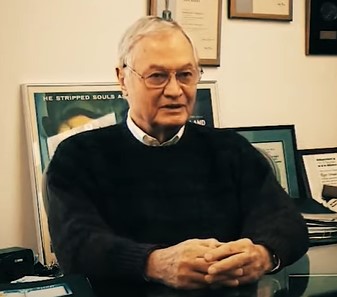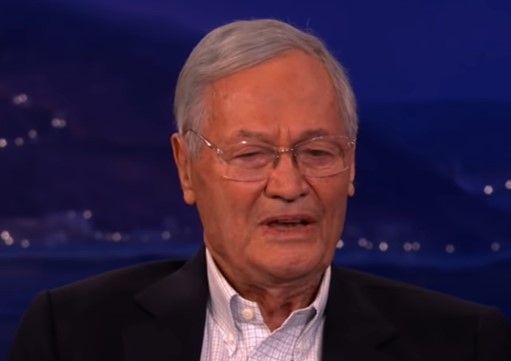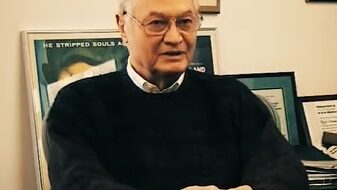WHO WAS ROGER CORMAN?

Roger Corman
Roger Corman is an American movie producer, director, and distributor. He was born on April 5, 1926, in Detroit, Michigan, United States, and passed away on May 9, 2024, in Santa Monica, California. He is recognized for his highly successful low-budget exploitation films and for launching the careers of a number of prominent directors and actors.
He has been referred to as “The Pope of Pop Cinema” and is respected as a pioneer in the field of independent filmmaking. A significant number of Corman’s films are adaptations of works that have already garnered acclaim from reviewers. One example of this is his series of low-budget cult films that were adapted from the stories of Edgar Allan Poe.
In 1964, Roger Corman, who was highly regarded by the French New Wave and Cahiers du Cinéma, achieved the distinction of being the youngest filmmaker to have his works showcased in a retrospective at the prestigious Cinémathèque Française, as well as the British Film Institute and the Museum of Modern Art. In addition to being a lifelong member of the Academy of Motion Picture Arts and Sciences, he was also one of the co-founders of New World Pictures and the founder of New Concorde. An Honorary Academy Award was bestowed upon him in 2009 in recognition of the significant impact he has had on the film industry and filmmakers.
Roger Corman’s Formative Years
Born in Detroit, Michigan, Roger Corman is the son of engineer William Corman and Anne (née High). He has a brother named Eugene Harold Corman, who has also produced a number of films, and he has done so on occasion in conjunction with Roger.
During the year 1940, the family of Roger Corman relocated from Detroit to Beverly Hills, California, which is located close to Hollywood. This relocation was the impetus for young Roger’s passion for motion pictures. Following his graduation from Beverly Hills High School, Corman continued his education at Stanford University, where he majored in industrial engineering. Roger Corman enrolled in the V-12 Navy College Training Program while he was a student at Stanford.
Following the conclusion of World War II, Corman went back to Stanford University to earn a degree in industrial engineering. His career in engineering lasted barely four days; he started working on Monday and quit on Thursday, informing his manager that he had made a terrible mistake. In 1948, he worked for a short period of time at U.S. Electrical Motors, which was located on Slauson Avenue in Los Angeles.
Early Career
Corman, who was more interested in film, initially got employment in the mail room at 20th Century Fox. After taking a break of one year to study English literature at the University of Oxford, he returned to the film industry in 1954 to co-produce his debut film, which was titled Highway Dragnet.
Among all of the properties that he liked the most and contributed ideas to, The Gunfighter was the one that was made with Gregory Peck. Following the fact that he was not given any credit at all, Roger Corman decided to leave Fox and pursue a career in movies on his own. Following his return to Los Angeles, he began his career in the film industry in 1953 as a producer and screenwriter. In 1955, he began directing films.
Roger Corman’s Advanced Career
The King of B-movies

Corman’s second picture, Monster from the Ocean Floor (1954), was produced in just six days with a budget of twelve thousand dollars. It was the first of his films to follow what would become his regular way of operation, which consisted of low-cost productions that were shot in the shortest amount of time possible, frequently in less than one week. In the same year, he also produced The Fast and the Furious for American Releasing Corporation, which would eventually become American International Pictures (AIP).
It was for AIP that Corman produced and directed a number of his most well-known films. In 1955, he directed his debut feature picture, which was a romantic western titled Five Guns West. The titles of many of the films that were directed by Roger Corman during the 1950s, such as The Beast with a Million Eyes (1955), It Conquered the World (1956), The Cry Baby Killer (1958; the film that marked Nicholson’s screen debut), and A Bucket of Blood (1959), among others, provide an indication as to why he was given the nickname “King of the Drive-in” or “King of the B-movies.”
The Little Shop of Horrors
Roger Corman was the producer and director of the cult classic The Little Shop of Horrors, which was shot in two days and one night on a set that had been left over from previous productions. Nicholson made a noteworthy cameo appearance in the film.
When he was at AIP, he looked for young filmmakers who were very inexpensive, and many of them went on to have successful careers. Each of Coppola and Bogdanovich earned early credits for re-editing Soviet science fiction films for Corman. These films included Battle Beyond the Sun (1959) and Voyage to the Planet of Prehistoric Women (1968), respectively.
Roger Corman also drafted Towne as an actor, but Towne concealed both contributions under the alias Edward Wain. The post-apocalypse tale Last Woman on Earth (1960) was written by Robert Towne, who would later become famous as the writer of the neo-noir film Chinatown (1974). Towne’s contributions were disguising himself as Edward Wain.
Edgar Allan Poe Movies
Over the course of the 1960s, Corman directed eight extravagant gothic horror films that were based on the works of Edgar Allan Poe. From 1960 to 1964, these films featured House of Usher, The Pit and the Pendulum, The Haunted Palace, and The Masque of the Red Death. Vincent Price starred in all of the Poe films, with the exception of one.
Other Cult Classic Movies
However, the horror genre was not the only genre that Corman worked in during that time period. In the 1962 film The Intruder, William Shatner played the role of a racist who incited racial unrest. The Wild Angels was a sleazy motorcycle movie that was released in 1966. It was based on the exploits of the Hells Angels and starred Peter Fonda, Bruce Dern, and Nancy Sinatra. The St. Valentine’s Day Massacre (1967) was a film that starred Jason Robards as Al Capone and was a very accurate depiction of the historic massacre that took place in 1929.
Bloody Mama (1970) was a violent portrayal of the Ma Barker story, starring Shelley Winters and Robert De Niro as one of her twisted sons. The Trip(1967), which was written by Nicholson, featured Fonda as a director of television commercials who experiences surreal visions after a first experience with LSD.
New World Pictures
Following his departure from AIP in 1970, Roger Corman established New World Pictures, an independent production firm that was responsible for the production and distribution of the works of a number of young filmmakers, including John Sayles, Martin Scorsese, Joe Dante, Jonathan Demme, and James Cameron. Its debut film, The Student Nurses (1970), was shot in three weeks for a total cost of $150,000 and went on to gross more than one million dollars. In addition, New World released films that were in the horror, blaxploitation, and women-in-prison genres.
As a result of the earnings made from these low-budget pictures, Corman was able to serve as the American distributor for a number of notable international films. These films include Cries and Whispers (1972) by Ingmar Bergman, Amarcord (1973) by Federico Fellini, and The Tin Drum (1979) by Volker Schlondorff. In 1983, Corman sold New World Pictures and established Concorde-New Horizons, a firm that is only focused on the production of motion pictures.
Other Projects
Over the course of his career, which spanned from the 1950s until the 2010s, Roger Corman produced or directed a large number of films. The vast majority of Corman’s films are unexpectedly amusing and literate, and they frequently feature a campy, self-deprecating sense of humor. This is despite the fact that their production values are plainly low. Due in large part to the fact that he discovered and promoted young actors and directors, he had a significant impact on the present American film industry.
In spite of the fact that Corman formally resigned from directing in 1971, he made a successful comeback with the film Frankenstein Unbound (1990). Corman was a sporadic actor who often made appearances in the films of others whose careers he had assisted. He appeared in supporting roles in the film The Godfather: Part II (1974) directed by Francis Ford Coppola, as well as in films directed by Jonathan Demme, including Philadelphia (1993), The Manchurian Candidate (2004), and Rachel Getting Married (2008). A number of other noteworthy films include Apollo 13 (1995).
In 1971, Corman collaborated with Jim Jerome to write an autobiography that was suitably titled How I Made a Hundred Movies in Hollywood and Never Lost a Dime.
Awards and Honors
In 1964, Roger Corman was the youngest producer and director to be honored with a retrospective at the Cinémathèque Française. In addition, he was honored with retrospectives at the British Film Institute and the Museum of Modern Art.
In the year 1998, he was the recipient of the very first Producer’s Award that was ever presented at the Cannes Film Festival.
Roger Corman was honored with the David O. Selznick Award by the Producers Guild of America in the year 2006.
Also in 2006, his picture Fall of the House of Usher was one of the twenty-five films that were chosen to be included in the National Picture Registry. The National Film Registry is a collection of important films that are being conserved by the Library of Congress.
An honorary Academy Award for lifetime achievement was bestowed upon him in the year 2009.
He was the subject of the documentary titled Corman’s World: Exploits of a Hollywood Rebel which was released two years later. At the very first Governors Awards, which took place on November 14, 2009, the Academy of Motion Picture Arts and Sciences presented Corman with an Academy Honorary Award in the year 2010.
In 2010, the writer and actor Mark Gatiss conducted an interview with Corman for his documentary series A History of Horror on the BBC. The interview was conducted for the second part of the second episode, which concentrates on Corman.
Roger Corman was honored with induction into the Beverly Hills High School Hall of Fame in the year 2010.
Roger Corman Dead
Roger Corman passed away on May 9 at his residence in Santa Monica, California, according to the statements made by his family on various social media platforms. There was no indication of what caused the death. He was generous, open-hearted, and friendly to everyone who knew him, according to a statement released by his family. The love that he had for his girls was profound since he was a selfless and loving father.
His legacy is not limited to the films he himself directed. A constellation of rising talents, including future A-list directors like Coppola, Scorsese, Howard, and Jonathan Demme, were drawn into Corman’s circle during the course of his career. His pictures were revolutionary and iconoclastic, and they were able to capture the spirit of an era.
RELATED: ROBERT LEE PARTON – THE REMARKABLE LEGACY OF DOLLY PARTON’S FATHER
